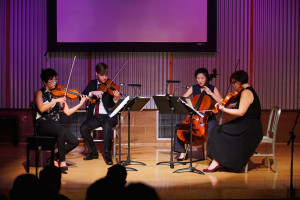 On Saturday, February 27, 2016 Boston Court in Pasadena hosted the Los Angeles-based composer collective Synchromy and The Argus Quartet who performed no fewer than 9 works of new music including three world premieres. A nice crowd filled the Marjorie Branson space to hear a concert titled walkabout that featured narration, video projections and music from seven different composers inspired by place and surroundings.
On Saturday, February 27, 2016 Boston Court in Pasadena hosted the Los Angeles-based composer collective Synchromy and The Argus Quartet who performed no fewer than 9 works of new music including three world premieres. A nice crowd filled the Marjorie Branson space to hear a concert titled walkabout that featured narration, video projections and music from seven different composers inspired by place and surroundings.
The first piece on the program was Sabina, by Andrew Norman from A Companion Guide to Rome, a collection of nine musical portraits based on churches in Rome. As Norman writes in the program notes: “The music is, at different times and in different ways, informed by the proportions of the churches, the qualities of their surfaces, the patterns in their floors, the artwork on their walls, and the lives and legends of the saints whose names they bear. The more I worked on these miniatures, the less they had to do with actual buildings and the more they became character studies of imaginary people, my companions for a year of living in the Eternal City.”
Sabina was performed on this occasion by Clara Kim of the Argus Quartet as a violin solo. This begins with a series of quiet whispers that evoke a light breeze or the wind whistling softly through the stone arches of a church. This builds gradually into some lovely notes and runs of sound that unfold to create a more active, complex texture. The playing becomes more animated through an interweaving of sounds – much like a tapestry of colored threads – but with an overall warmth and wistfulness that is very appealing. All of this was performed with great skill by Ms. Kim who kept everything balanced and moving crisply forward. Towards the conclusion the pace slowed and a series of singularly high, thin notes coalesced into what could have been a simple hymn tune to finish out. For those who are familiar with Norman’s orchestral works – full of power and fury – Sabina reveals a more sensitive compositional touch and is a beautifully sketched likeness of a charming subject.
Cloud Trio, by Kaija Saariaho was next and a brief spoken introduction by narrator Chelsea Fryer was given about the instrumentation prior to the playing of this piece. As quoted from the program notes: “In this piece, the three instruments all have different tasks and functions, they represent very different aspects of string playing. These tasks are sometimes very concrete: the violin tends to behave as an echo or reverberation, the viola creates new clouds next to the existing ones and the cello often has a function of a shadow to the upper instrumental lines.”
Images of clouds moving slowly across a blue sky were projected on the screen above the stage and Cloud Trio began with smooth, sustained lines from each instrument that produced some enchanting harmony. As the piece progressed there was a more active feel in the violin – almost like the falling of rain drops – and a rapid, complex intertwining of the parts. Over the four sections of this work each of the instruments rose to the top of the texture only to be replaced with another, and this produced a fascinating series of combinations. The volume, rhythm or complexity would increase and then subside, and the feeling was variously mysterious, lethargic or dramatic, as if a series of different clouds were drifting by. A captivating violin solo emerged just as the piece finished and the Argus players carefully drew out each of the nuances in this well-played performance. Cloud Trio is imaginative music that invites the listener to conjure up vivid atmospheric images.
The world premiere of funeral song for the people of the ruined cities, by Zaq Kenefick followed and for this piece the full Argus Quartet took the stage. This music is an exploration of what hypothetical folk music might sound like for a people who have lost their cultural memory after some long-ago calamity. A short narration preceded the start of this and an anxious trill in the violin opened the piece with a strong sense of foreboding. Tutti passages followed with a growling sound in the cello and strong strumming of the viola. There is a rough, edgy feel to this – all is unsettled and seemingly in chaos. Despite its short playing time, funeral song for the people of the ruined cities is an expressive and unnerving musical glimpse into the grim future of a people who must exist without a past.